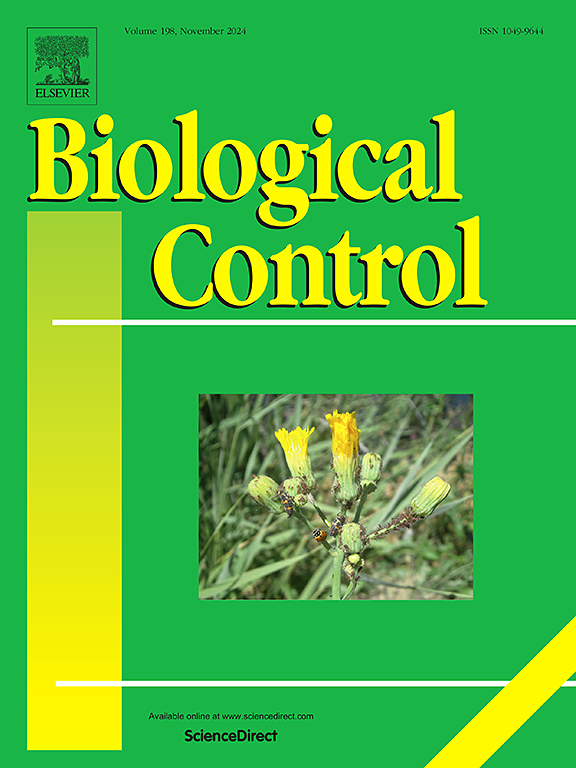大量释放敏感雄虫可稀释粉棉铃虫Bollgard II®Bt抗性:半田间验证策略
IF 3.4
2区 农林科学
Q2 BIOTECHNOLOGY & APPLIED MICROBIOLOGY
引用次数: 0
摘要
粉红色棉铃虫Pectinophora gossypiella(鳞翅目:球蛾科)由于对Cry1Ac和Cry2Ab毒素具有田间抗性,对印度Bt棉花种植构成重大威胁。现有的有害生物管理策略已被证明是不够的。为了解决这个问题,在实验室中大量饲养纯合子敏感(RR)雄蛾,并将其释放到Bt Bollgard II®棉田中。在释放易感雄鼠之前,用信息素诱捕和清除具有抗性的雄鼠,提高了成功率。使用生物测定、抗性稀释遗传学、适应度成本估算、现场验证和基因表达分析来评估有效性。在实验室回交后代和野外野生雌性与释放易感雄性交配的后代中,抗性稀释都很明显。两种毒素的抗性均为常染色体隐性遗传。处理后小区棉铃损伤和幼虫数量显著降低。与Bt抗性相关的基因,包括PgCad1、PgABCA2、APN和ABCG8,显示出显著的下调(分别为- 4.93倍、- 2.63倍、- 1.73倍和- 1.49倍),表明田间采集的幼虫在交配后(Field-R♀×实验室- s♂)部分恢复了抗性。这些发现突出了大规模释放易感雄性棉铃虫作为一种有效和可持续的管理抗bt棉铃虫策略的潜力,为传统的基于杀虫剂的方法提供了一种替代方法。本文章由计算机程序翻译,如有差异,请以英文原文为准。

Mass release of susceptible males dilutes Bollgard II® Bt resistance in pink bollworm: A semi-field validated strategy
The pink bollworm, Pectinophora gossypiella (Lepidoptera: Gelechiidae), poses a significant threat to Bt cotton cultivation in India due to field-level resistance against Cry1Ac and Cry2Ab toxins. Existing pest management tactics have proven inadequate. To address this, homozygous susceptible (RR) male moths were mass-reared in the laboratory and released into Bt Bollgard II® cotton fields. Success was enhanced by trapping and removing feral resistant males with pheromone traps prior to releasing susceptible males. The effectiveness was assessed using bioassays, resistance dilution genetics, fitness cost estimation, field validation, and gene expression analysis. Resistance dilution was evident in both laboratory back-cross progenies and field progenies from feral females mated with released susceptible males. Resistance was autosomal with recessive inheritance for both Cry toxins. In treated plots, boll damage and larval numbers were significantly reduced. Genes linked to Bt resistance, including PgCad1, PgABCA2, APN, and ABCG8, showed significant down regulation (−4.93, −2.63, −1.73, and −1.49 fold, respectively), indicating partial restoration of susceptibility in field-collected larvae following mating (Field-R ♀ × Lab-S ♂). These findings highlight the potential of mass-releasing susceptible males as an effective and sustainable strategy for managing Bt-resistant pink bollworm, providing an alternative to traditional insecticide-based approaches.
求助全文
通过发布文献求助,成功后即可免费获取论文全文。
去求助
来源期刊

Biological Control
生物-昆虫学
CiteScore
7.40
自引率
7.10%
发文量
220
审稿时长
63 days
期刊介绍:
Biological control is an environmentally sound and effective means of reducing or mitigating pests and pest effects through the use of natural enemies. The aim of Biological Control is to promote this science and technology through publication of original research articles and reviews of research and theory. The journal devotes a section to reports on biotechnologies dealing with the elucidation and use of genes or gene products for the enhancement of biological control agents.
The journal encompasses biological control of viral, microbial, nematode, insect, mite, weed, and vertebrate pests in agriculture, aquatic, forest, natural resource, stored product, and urban environments. Biological control of arthropod pests of human and domestic animals is also included. Ecological, molecular, and biotechnological approaches to the understanding of biological control are welcome.
 求助内容:
求助内容: 应助结果提醒方式:
应助结果提醒方式:


